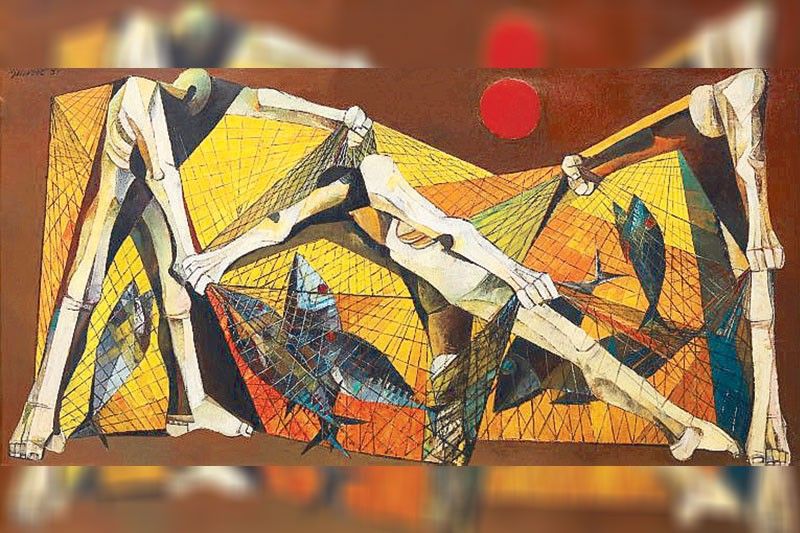Seeing 2020: Art in the last decade


As we careen into 2020, here’s a look at the art trends and milestones that defined the last 10 years, the better to forecast what’s ahead in the brand new decade.
The arrival of artist managers
One of the most important developments in the last decade has been the arrival of the “artist-manager.” (For those on the opposite side of the fence and who manage art collections, the new species would be called the “art adviser.”) These tastemakers have become influential to interpret the increasingly complicated art market and its potentially confusing pricing schemes.
At the beginning of every art exchange is the “primary” market. This is where artworks change hands from the artist to the collector for the very first time, traditionally through a gallery. Since the establishment of the seminal Philippine Art Gallery in 1952, Filipino artists have been tied to a gallery pretty much exclusively, like a Steph Curry or LeBron James to their home teams. In recent years, however, artist managers have taken over the role of charting careers and minding the gate. With a manager in place, more and more artists have become “free agents,” able to exhibit in different galleries.
Whether it’s a gallerist or an artist manager, a tight guard is always kept on who can (and just as importantly, cannot) be allowed to purchase a key piece. Where an artwork hangs is considered to be as important as the artwork itself and falling into the wrong hands, or going to a collector notorious for reselling (or ‘flipping’) can erode the artist’s carefully cultivated value.
At this ground zero, prices for artworks would be at their lowest. That preferential rate is used to entice important collectors to come in, buy a work — and to continue to do so.
The next stage of the acquisition process is the “secondary” market. This is when art is traded through an informal network of professional dealers as well as through friends of the artist or artist manager. It is a further test of the artist’s mettle. One can even say that it is easy enough to have a “sold out” show these days — but can these pieces find a second or even third or fourth home, at increasingly higher prices?
At the very top of the food chain are artists whose output is so rare or in such demand, that the only way to acquire them is to go to the auction arena.
This takes us therefore to the Olympus of art exchanges and to one of the defining developments of the last decade.
The rise of auction houses
What happens when you are unable to acquire a certain artist on the gallery level — and not a single collector is willing to part with his treasures in the secondary market? The only recourse would be to go to battle for it with your checkbook at a trusted auction house.
Auctions, after all, are the last democratic outpost of the art world. You don’t have to be on the gold list of a gallery, nor do you need to have friends in high places. Auction prices are also considered an important barometer of an artist’s career. Take note, this is not just a measure of the quality of an artist’s outpost, but also an economic indicator of the demand for his work versus the available supply.
The Filipino auction house, incidentally, has made various appearances before 2010. There have been three or four of them up and running, run by either taipans as well as their Filipino-Spanish counterparts in the ’80s and ’90s. The eminent scholar Ramon Villegas ran one, when he would actually act as the auctioneer with his signature air of boredom. Dame Deanna Ongpin put one together to benefit a children’s home and racked up an impressive seven-figure total in revenues. For one reason or another — mainly because the enterprises need one’s undivided attention — these houses folded or went into retirement.
It wasn’t until this last decade, however, that the auction business once again began in earnest. By 2015, auctions had become a force with which to reckon.
It hasn’t been all roses, however, with auction houses becoming symbols of the “commercialization” of art. Is that such a bad thing, one wonders. Ask the dozens of successful artists who are finally getting their due — and crying all the way to the bank.
But as the old law of physics says, for every reaction, there is an equal and opposite reaction. The mischievous graffiti artist Banksy pranked a top international auction house in 2018 when his “Girl with a Balloon” proceeded to shred itself as soon as the hammer came down. (Never mind that the auction set a world’s record for him.) What was intended to be a barbed commentary on moneymaking in the art world has now purportedly doubled the value of the painting, thanks to the publicity generated by this stunt.
The burgeoning business of authentication
As a consequence of the arrival of auctions, there has been an increased demand for third-party authentications. Thus, the offspring, who one presumes were witnesses to their father’s artistic exertions, or in some cases, the wives — and in still other instances, the well-known “second ladies” — who kept a ledger of sales have become important authorities on artworks. Botong’s “last apprentice,” Salvador Juban, who began to work for Carlos V. Francisco in his teens is an example of an authenticator who studied his mentor close up and through the years.
Art Fairs: Three’s a crowd?
The artist and collecting elite like to gather in the annual ritual known as the “art fair.” Since 2013, the hottest VIP pass is for simply called Art Fair Philippines. It had an original setting at the Link Carpark and was a centerpiece project of the Ayala Center in Makati.
In the middle of 2019, however, a so-called “breakaway” group of 10 galleries decided to set up on their own at SM Aura in Taguig City. Dubbed the “Alt Fair,” it is scheduled to open on the weekend preceding the Art Fair Philippines’ dates.
The mavens of AFP — Mesdames Trickie Lopa, Dindin Araneta and Lisa Periquet — remain cool and collected. After all, the headcount of Art Fair Philippines’ galleries in 2019 was 54. This 2020, there are 60; 19 of these are foreign galleries, up from 15 international names this year.
The Italian Ambassador Giorgio Guglielmino, who also happens to be a serious art aficionado, had this to say in his column, “Perhaps it is not too late for an attempt to settle the differences? Not for the sake of individual galleries or individual personalities. But for quality artists that exist in the Philippines and deserve to be seen.” (At any rate, Guglielmino has arranged for the Galleria Tiziana di Caro contemporary art gallery to join the Art Fair Philippines roster this coming year.)
Blockbuster Exhibitions
Move over U2, the thing to do is not to risk life and limb in a rock concert but to expand one’s mind in the landmark exhibitions that have exploded across the world.
Beginning with Yayoi Kusama’s ground-breaking “Infinity Mirrors” at the Hirshhorn Museum in 2017 in Washington D.C., the biggest and brightest museums have competed for the most spectacular art shows.
Korean-American video superstar Nam June Paik has launched a remarkable five-city retrospective tour of his works that kicked off at the Tate Modern in London and will speed to the Stedelijk in Amsterdam and then the Chicago Museum of Modern Art, in spring and fall of 2020 respectively. (Manila had its very first Nam June Paik show at León Gallery International last year with the interesting participation of the behemoth Gagosian Gallery.)
The Philippines’ return to the Venice Biennale in 2015 — after more than 50 years’ absence — was also a defining moment of the last decade. Mark Justiniani’s brilliant debut in 2019 was also declared an essential Biennale experience.
Old masters, modern masters and the hyper-contemporary
Leonardo Da Vinci brought back the spotlight to the Old Masters, with the controversial “Salvator Mundi” becoming the world’s most expensive painting at almost half a billion dollars at a 2017 auction. The masterpiece stole the thunder from previous record holder, Picasso’s “Las Femmes de Alger” which chalked up $178 million at a 2015 auction.
Works by 19th-century icons, Juan Luna and Felix Resurreccion Hidalgo achieved Philippine records, as did Lorenzo Guerrero — who mentored them all. Guerrero’s petite masterpiece “At River’s Bend” had the highest value inch for inch, achieved at León Gallery in 2018.
Ronald Ventura would define the era by being the first contemporary artist to join the million-dollar club in 2011; so did BenCab who marked his 50th creative year in 2015 with a grand slam of eight museum retrospectives, several books as well as must-have memorabilia.
Modern Masters continued their dominance, with Jose Joya leading the pack with “Space Transfiguration” as the most expensive painting in the country, at P112 Million in 2018. This was followed by benchmarks achieved by Ang Kiukok, Anita Magsaysay-Ho, Vicente Manansala and Fernando Zobel, in that order. (All records achieved by León Gallery halfway through the last decade, beginning in 2015.)
International data supports the view that Old Masters foreshadow the continuing upward trend for treasures from the turn of the century.
What’s ahead in 2020? Art imitates life yet again: All is a cycle.


















